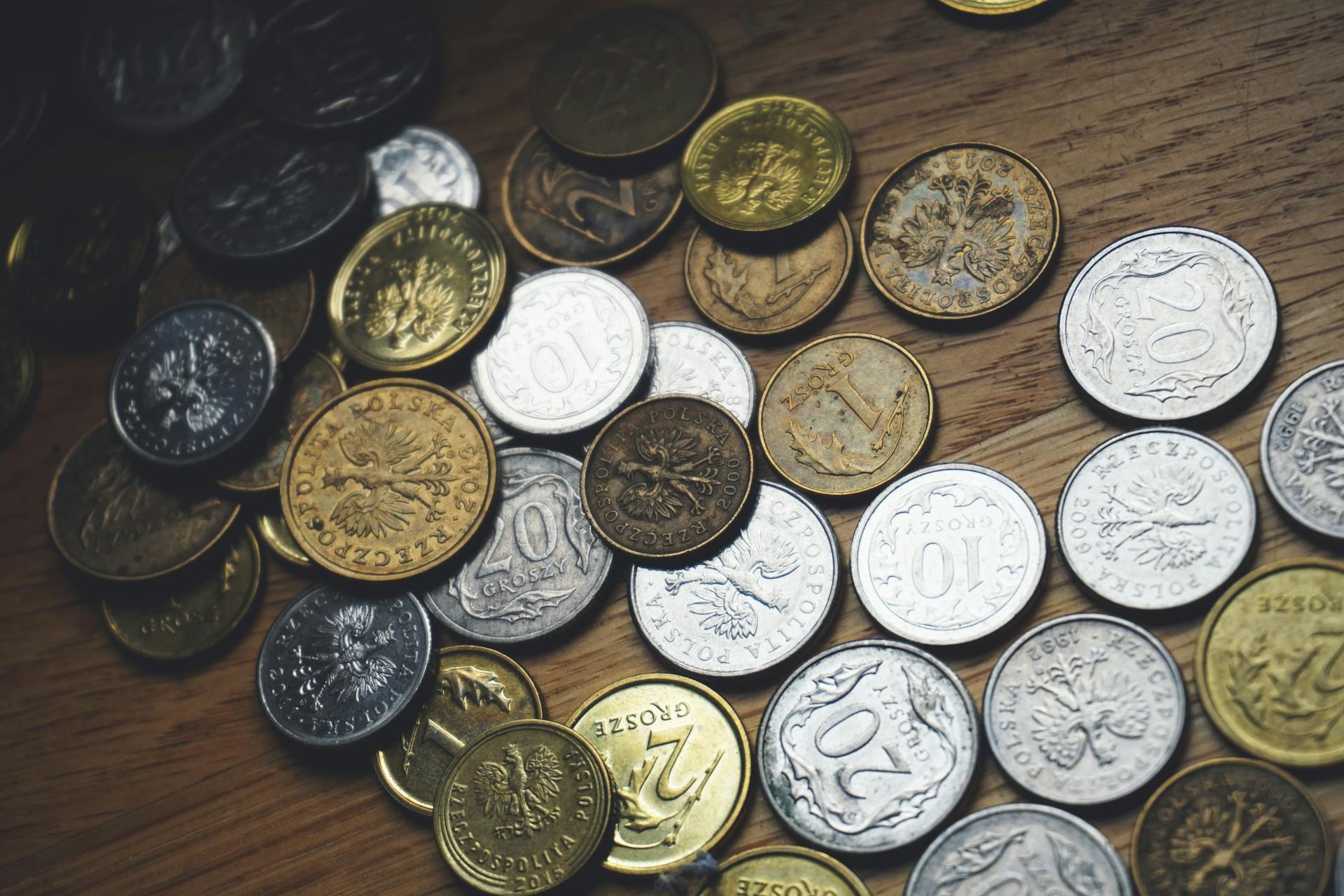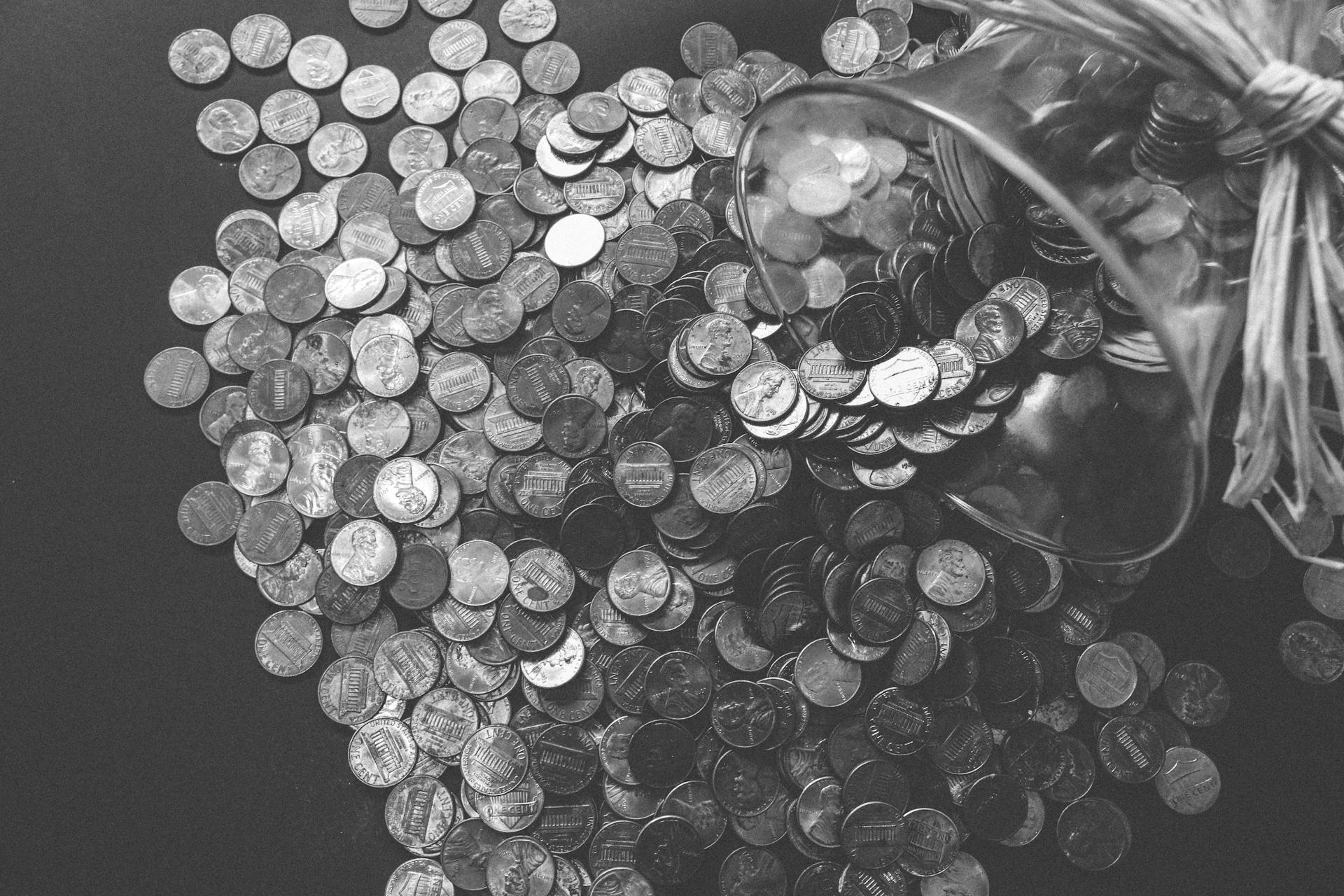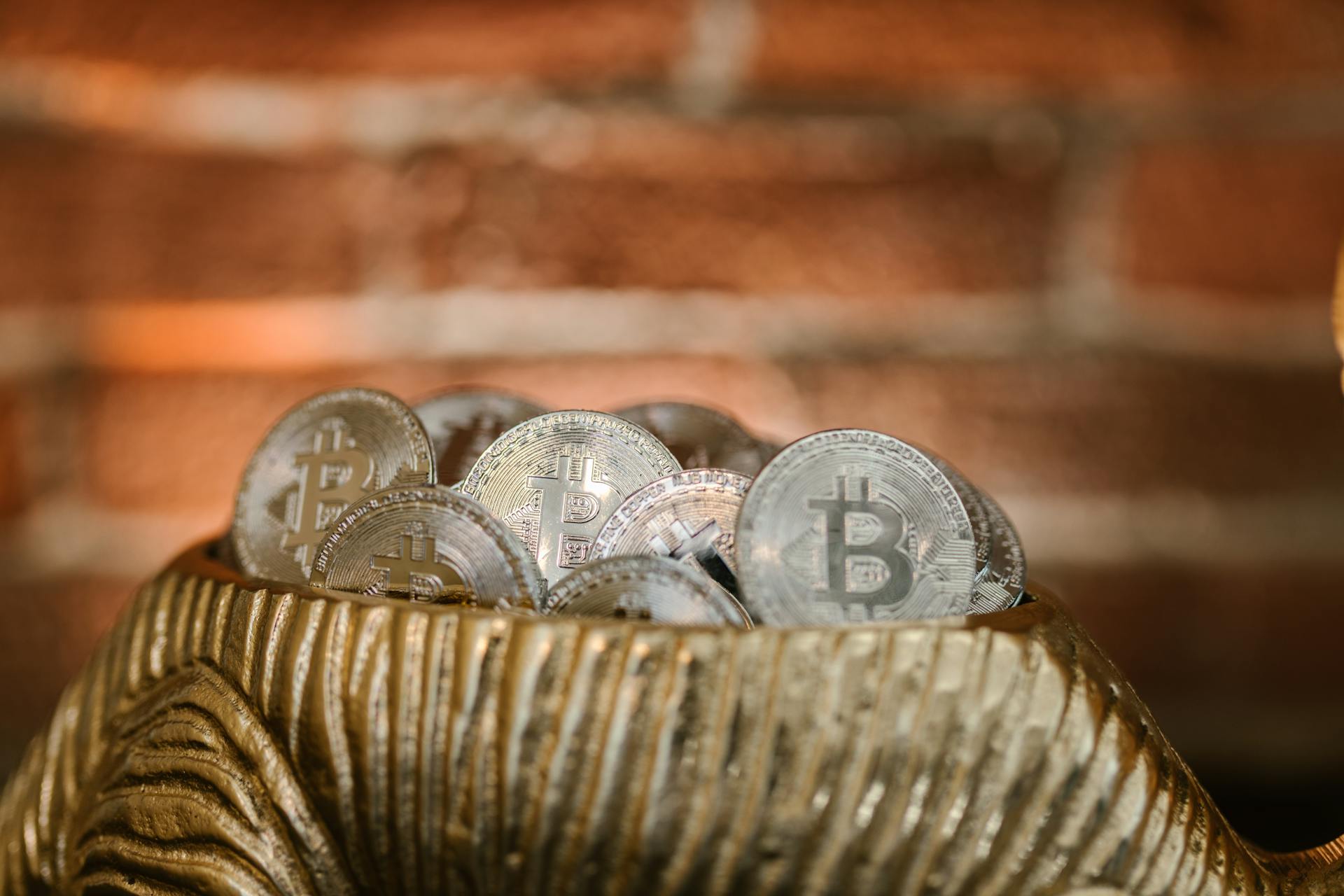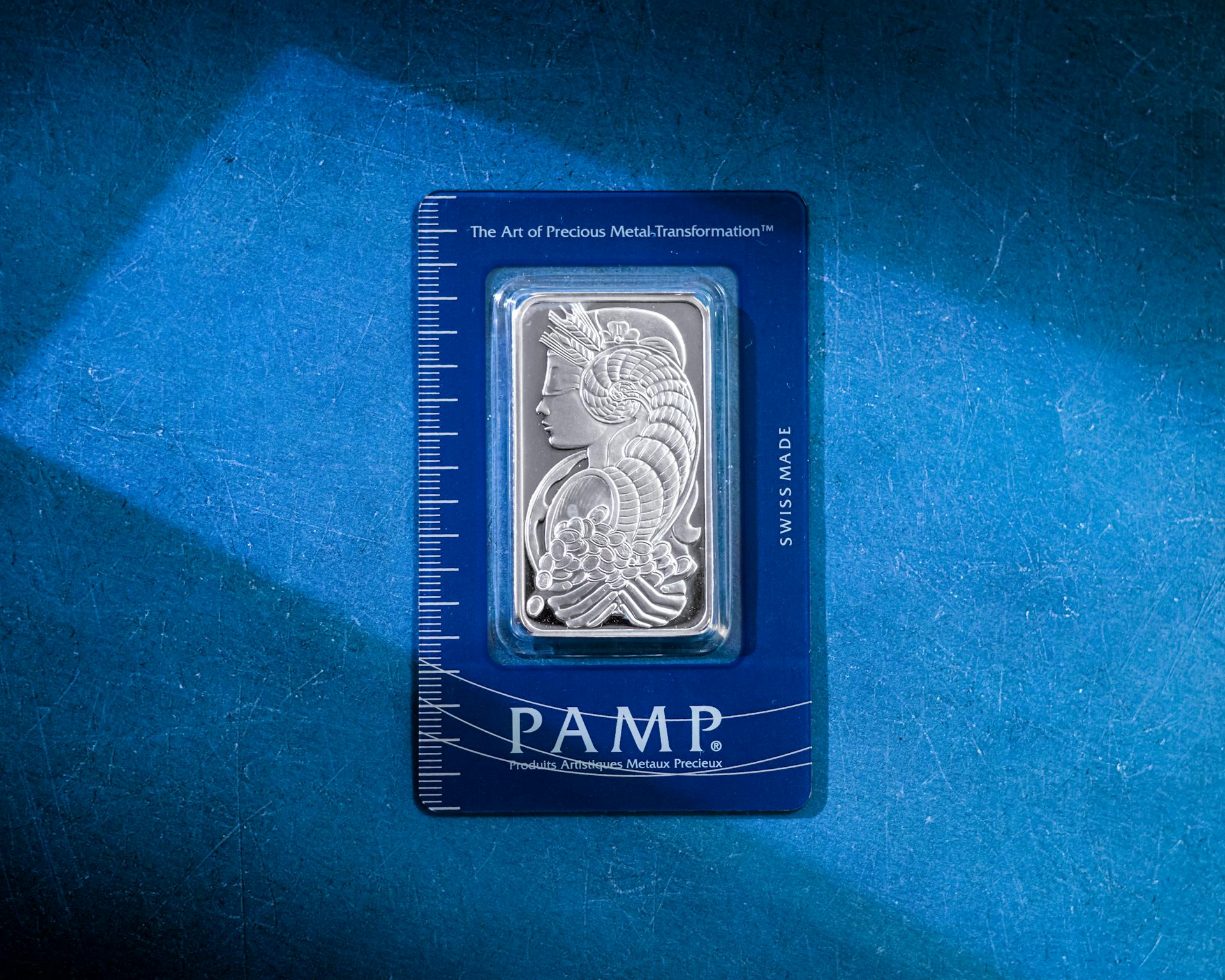
The concept of sterling silver dates back to the 12th century when the English currency was introduced.
The first English coins were minted in the 8th century, with the penny being the most widely used denomination.
These early coins were made from silver and gold, with the gold coins being used for more significant transactions.
The use of sterling silver in English coins began in the 12th century, with the introduction of the silver penny.
The gold standard was adopted in 1717, allowing the British government to peg the value of the pound to the value of gold.
This system remained in place until 1931, when the UK abandoned the gold standard due to economic pressures.
Consider reading: Usd Sterling Exchange Rate History
Pre-Decimal Origins
The origins of pre-decimal coinage in England date back to the seventh century, when the Frankish kingdom's custom of reckoning in librae of 20 solidi and 240 denarii crossed over into England.
This system was based on the gold tremissis, which was considered a solidus in the western Mediterranean, and the new silver denarius, which was its 12th part. The first English pennies were struck in silver in the seventh century, but they varied greatly in weight.
Recommended read: Building Societies in England
The weight of silver pennies became more consistent under William I, and it's from this time that the pound as a unit of currency of 240 pence originated. The £ sign, which is the abbreviation for the pound, developed from the Latin word libra.
The £ sign has undergone changes over the years, with the first known use of the symbol being on a cheque dated 7 January 1661. The letters s and d, which stand for solidus and denarius, respectively, were first used to indicate shillings and pence in 1387.
These Latin abbreviations were likely applied to the English shillings and pence during medieval times, when Latin and English were both in use. The name shilling comes from the Old English scilling or scillinga, meaning cutting or slice.
Origins of Sterling
The origins of the word sterling are quite fascinating. It's associated with the Middle English word ster, meaning strong, rigid, or fixed.
In medieval England, the English penny gained a reputation abroad as a strong and fixed currency, weighing consistently at 22.5 grains. This consistency was a result of the reign of William I, who kept the weight of the penny the same for two centuries.
The name sterling came to represent the English currency as a whole, especially abroad, and was also used in a domestic context by famous writers like Chaucer and Shakespeare.
As the English currency grew, the name sterling stuck, even as the currency itself evolved. Today, we still use the term to describe the British currency, and it's a testament to the country's rich history of economic evolution.
Curious to learn more? Check out: Sterling Coins in Circulation
Origins of Sterling
The origins of sterling are shrouded in mystery, but one thing is certain - it's a word that's deeply rooted in history. The term "sterling" is often associated with the British currency, but it actually originated from the Middle English word "ster", meaning strong, rigid, or fixed.
Discover more: 1967 Sterling Devaluation
In the late 11th century, the English penny became heavier and more consistent in weight, earning a reputation as a strong and fixed currency. This reputation was reflected in the use of the word "sterling" as an adjective in continental documents.
The name "sterling" eventually came to represent the English currency as a whole, and it's still used today to describe the British currency. This is a testament to the enduring legacy of the medieval English currency system.
Interestingly, the word "sterling" has also taken on a broader meaning, encompassing qualities such as steadfastness, honour, and integrity. This is a fascinating example of how language evolves over time, reflecting changing cultural values and norms.
The association of sterling with strength and stability is a lasting legacy of the medieval English currency system.
Two
The two pound coin has been a staple in British currency since 1997, featuring three different portraits of Queen Elizabeth II and now King Charles. It's a silver-colored center with a gold-colored edge.
Take a look at this: Colored Coins
The design of the two pound coin has undergone changes over the years, with the front side being designed by Jody Clark in 2015.
The reverse side of the two pound coin has also changed, with the original coin designed by Bruce Rushin featuring a group of connected gears and the inscription "standing on the shoulders of giants." This design symbolized Britain's technical advancements from the Iron Age and the Industrial Revolution.
The newest two pound coin in circulation today features Antony Dufort's Britannia design with the inscription "quatuor maria vindico", which translates to "I will claim the four seas."
Purpose of Issuing
The British one pound coin was introduced to replace the one pound note, which had a surprisingly short lifespan of approximately 9 months in circulation. This was due to the notes often being damaged or defaced after repeated use.
The Royal Mint found that a pound coin could remain in circulation for 40 years or more, making it a much more durable option. This led to the government's decision to phase out the one pound note in favor of the coin.
The introduction of the pound coin was announced on 31 July 1981, marking a significant change in the way people paid for goods and services in the UK.
Readers also liked: Coins in Circulation in Uk
Coins
Coins have been an essential part of England's economy for centuries.
The first English coins were minted in the 7th century, with the first gold coins introduced by King Offa of Mercia.
These early coins were made from silver and gold, with the silver coins being the most widely used.
The first copper coins were introduced during the reign of King Henry II in the 12th century.
These copper coins were used for small transactions and were often used in conjunction with silver and gold coins.
The most iconic English coin is probably the penny, which has been in circulation since the 8th century.
Take a look at this: What Is the Currency for Paris France
Shilling
The shilling has a long history that dates back to the 16th century when it was first introduced as a coin.
The shilling was introduced at the beginning of the 16th century.
Its introduction marked a significant milestone in the evolution of currency, paving the way for the widespread use of coins in everyday transactions.
The shilling as a coin was introduced at the beginning of the 16th century.
Fifty
The 50p coin is a seven-sided, silver coin. I remember being fascinated by its unique shape when I first saw one.
It was first created in 1969. This was a significant year for British currency.
The coin features Queen Elizabeth's profile on the front, although it now has King Charles' profile. I'm not sure what the change in monarch means for the design, but it's interesting to note the update.
Twenty
The Twenty Pence Coin is a seven-sided silver coin featuring Queen Elizabeth II or King Charles on the front. It's easy to get confused with the 50p coin, but a quick check of the reverse label will tell you it's 20p.
One of the key ways to tell the Twenty Pence Coin apart from the 50p coin is the label on the reverse, which clearly states "20 pence". This is a crucial piece of information to keep in mind when handling these coins.
The Twenty Pence Coin has a portrait of Queen Elizabeth II or King Charles on the front, and a piece of the Royal Shield on the back. This design is similar to the 50p coin, which is why it's so easy to get them mixed up.
Ten
The 10p coin is a great example of the different denominations we have. It's round and silver.
You can spot the 10p coin easily, as it features an image of Queen Elizabeth II or King Charles on the front.
Five
The Five pence coin is a small round coin made of silver, featuring Queen Elizabeth II or King Charles on the front.
It's worth noting that the 5p coin is much smaller than the 50p, 20p, and 10p coins.
The Royal Shield is featured on the reverse side of the 5p coin, alongside the other coins of similar size.
One
The one pence coin, commonly known as a penny, is the lowest value coin in British currency. It's a copper coin that's widely used in everyday transactions.
One pence coins are small and easy to carry, making them a convenient option for small purchases.
The Round £1
The Round £1 is a unique coin in the UK's currency system. It was introduced in 1983 to replace the old £1 coin, which featured a crowned portrait of Queen Elizabeth II.
The Round £1 coin is made of nickel-brass and features a bi-metallic design, with a gold-colored outer ring and a silver-colored inner ring. The coin's design has undergone several changes over the years.
One of the most notable features of the Round £1 coin is its security features, including a latent image of the Royal Shield that appears when the coin is tilted. This makes it difficult to counterfeit.
The Round £1 coin has been widely used in the UK, with over 9 billion coins minted since its introduction.
Suggestion: Us Currency Security Features
Design and Counterfeiting
In the early days of the round one pound coin, counterfeiters took to duplicating it, with an estimated 3.04% of counterfeit coins in circulation by 2013.
The geographical areas with the maximum number of counterfeit coins were Northern Ireland, the South-East of England, and the City of London.
Many banks didn't check the coins they were receiving, leading to a significant number of counterfeit coins making their way into circulation.
The Design of
The Design of the Pound Coin is a fascinating topic, and one that has undergone significant changes over the years. The obverse of the pound coin bears a Latin inscription that reads ‘Elizabeth II D G REG’, which translates to “Elizabeth II, by the Grace of God, Queen and Defender of the Faith”.
This inscription has remained relatively unchanged since the original release of the pound coin on 21 April 1983. The year of the mintage was also engraved alongside the Latin inscription, which has helped to track the coin's history.
Four portraits of Queen Elizabeth II have been used on the pound coin since its release. The first series of coins released in 1983 used a portrait created by designer Arnold Machin, featuring the Queen wearing a tiara. A new portrait created by Raphael Maklouf was introduced in 1985, depicting the Queen wearing the George IV State Diadem.
The design of the pound coin was changed again from 1998 to 2015, with a new portrait created by Ian Rank-Broadley. This portrait also featured the Queen wearing a tiara. A makeover of the pound coin took place in 2015, with well-known designer Jody Clark creating a new design that depicts the Queen wearing the George IV State Diadem.
The reverse of the pound coin has undergone significant changes since 1983, with a new emblem representing each geographic area of the UK introduced each year. The words, “one pound” can be found on the reverse of all these coins.
For your interest: What Currency Is Used in Prague Czech Republic
Counterfeit

Counterfeit coins started circulating in large numbers, with an estimated 3.04% of them in circulation by 2013. They were particularly prevalent in Northern Ireland, the South-East of England, and the City of London.
Banks often didn't check the coins they received, which led to many of them being inundated with counterfeit currency. This was a major problem.
The Royal Mint commissioned coin testing companies to study the issue, but the actual number of counterfeit coins was found to be approximately twice what they estimated.
Many counterfeit coins had poor quality and noticeable design differences, making them easier to detect.
Christopher Ironside
Christopher Ironside was a renowned designer of banknotes and coins. He prepared the reverse designs for all new denominations introduced during decimalisation.
His expertise was crucial in creating the iconic designs that we see on our currency today.
Frequently Asked Questions
What are the actual British coins?
British coins are made from various metals, including copper-plated steel, nickel-plated steel, cupronickel, and bimetallic materials. The specific composition varies by denomination, ranging from one penny to two pounds.
How many pounds is a quid?
A quid is equal to £1, or one pound sterling. This is the standard value of the British currency's colloquial nickname.
What UK coins are still valid?
The UK still accepts various coins, including the Crown (£5), £2, £1, 50p, 20p, 10p, and 5p coins, each with specific usage limits. These coins can be used for any amount, up to their respective maximum values.
Is a pound coin worth anything?
A pound coin's value depends on its rarity, with some old coins potentially worth keeping due to their scarcity. Check the Scarcity Index on ChangeChecker.org to determine if your coin is rare and valuable.
Sources
- https://www.royalmintmuseum.org.uk/journal/history/pounds-shillings-and-pence/
- https://www.tripsavvy.com/uk-currency-photographs-4123326
- https://www.royalmint.com/discover/uk-coins/coin-design-and-specifications/one-pound-coin/
- https://www.spink.com/media/view
- https://www.physicalgold.com/insights/a-complete-history-of-the-british-pound-coin/
Featured Images: pexels.com


